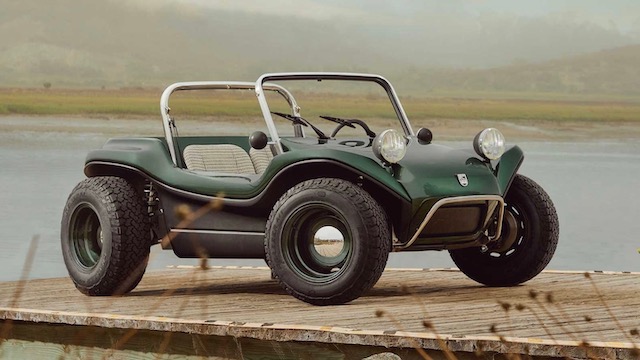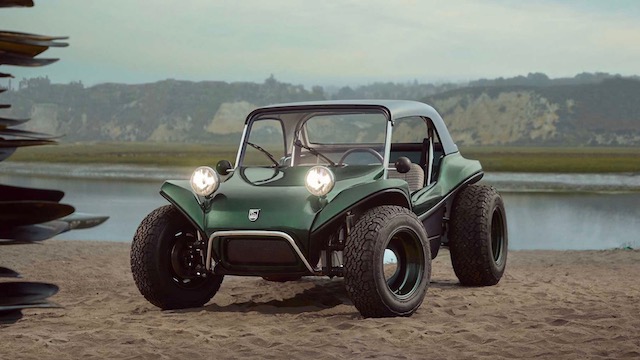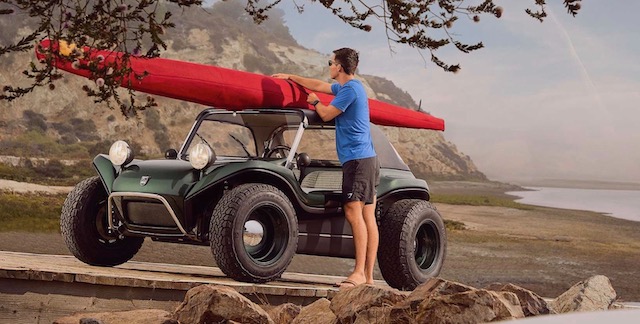
The Volkswagen dune buggy is back, although Volkswagen itself has nothing to do with the revival of this particular model.
The newcomer is called the Meyers Manx 2.0, after the two-seater dune buggy that American Bruce Meyers unleashed on the world almost 60 years ago.
But whereas Meyers’ buggy was based on a VW Beetle chassis and powered by an air-cooled, four-cylinder petrol engine, Meyers Manx 2.0 is an all-electric fun machine sitting on an all-aluminium chassis.
It looks much the same as the 1960s original – note the headlights on stalks. Meyers Manx 2.0 will be unveiled at California’s Monterey car festival next week where the order book for the first 50 ‘beta’ cars (where depositors can apply to participate in production) will be opened for delivery in 2023. Full scale production begins in 2024.
The story of the VW beach buggy culture begins in 1964 when boatbuilder and World War II US Navy veteran Meyers was seeking a lightweight alternative to the heavy four-wheel drive Jeeps and the like that back then dominated off-road races like the Baja California event on the Mexican peninsula.
He took cutting tools to a VW Beetle, chopped off the tail, shortened the chassis, dropped a fibreglass shell on it, and, after tweaking his completely open design over a couple of years, set a record time by five hours in the 1967 Baja California race. The Meyers Manx quickly became a cult classic, spawning an estimated 250,000-300,000 Beetle-based variations worldwide into the 70s and 80s.
Movie star Steve McQueen drove a customised Meyers Manx in a beach scene with Faye Dunaway in the 1968 film The Thomas Crown Affair. Modifications included replacing the 30kW Beetle engine with 135kW flat-six unit from the Chevrolet Corvair. The buggy was later sold privately and the owner swapped the Chevvy engine for a lighter 2.2-litre Porsche unit. It was eventually sold at auction in 2019 for $US456,000.
The rear-wheel-drive Meyers Manx 2.0 has an onboard 6kW charging system and optional fast charging up to 60kW. It is powered by twin electric motors fed by optional batteries, a 20kWh unit or a 40kWh version. Claimed range is 240 or 480km.The smaller battery develops a reported 150kW/325Nm. Tests with the 40kWh battery show the vehicle will do 0-100km/h in 4.5 seconds, says the company.
The buggy was penned by American Freeman Thomas, a car industry veteran whose design credits include VW’s new Beetle, the Audi TT and a string of Chrysler concept cars.
Thomas is also the CEO of Meyers Manx. He said of the Manx 2.0 buggy: “It’s simple and endearing and taps into the spirit of playfulness. The ageless design brings out your inner child. It’s about passion.”
Manx has about 50 full-time employees. “I have designers that are coming from Porsche, from Audi, from Volkswagen, that just wanna be part of Manx,” Thomas said. “In some funny way, we are becoming the ‘It’ brand among designers.”
- Meyers (above with his original) named his dune buggy after the Manx cat, which has a stub tail. Heavy competition forced him to close his business in 1971 after producing around 6000 cars. He opened again in 2000 to build kits for the original Manx. Meyers died in 2021, aged 94, a year after selling the company to the venture capitalists behind CEO Thomas and the Meyers Manx 2.0 project. Volkswagen unveiled its own electric buggy at the Geneva motor show in 2019. But it hasn’t moved forward with what it called the ID Buggy, despite confirming that its born-again electric Kombi will go into production as part of the ID family of EVs.




